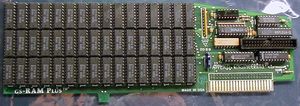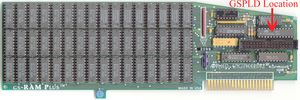GS-RAM Plus: Difference between revisions
No edit summary |
|||
| (12 intermediate revisions by 2 users not shown) | |||
| Line 1: | Line 1: | ||
The GS-RAM Plus is a RAM Board capable of 6 Meg on-board for the Apple IIgs computer made by Applied Engineering (aka - AE). | The GS-RAM Plus is a RAM Board capable of 6 Meg on-board for the Apple IIgs computer made by Applied Engineering (aka - AE). | ||
The DRAM used are standard 1Meg x 1bit DRAMs, and the board can be expanded 1 Meg at a time. AE's rare optional 2 MEG Piggyback Card could also be installed and expand the RAM up to a total of 8 Megs, however this was rarely if ever done due to the cost of RAM at the time. AE also claims the board is "fully DMA (direct memory access) compatible", however this can't be so since the PFI/CYA isn't being bypassed on the IIgs motherboard | The DRAM used are standard 1Meg x 1bit DRAMs, and the board can be expanded 1 Meg at a time. AE's rare optional 2 MEG Piggyback Card could also be installed and expand the RAM up to a total of 8 Megs, however this was rarely if ever done due to the cost of RAM at the time. AE also claims the board is "fully DMA (direct memory access) compatible", however this can't be so since the PFI/CYA isn't being bypassed on the IIgs motherboard nor was any software ever written to test or take advantage of DMA-able RAM above 4 Megs. | ||
The GS-RAM Plus board had a several revisions and required certain GAL revisions in order to work in either the ROM1 or ROM3 IIgs. No one GAL revision existed which allows the RAM board to work in both IIgs systems. | The GS-RAM Plus board had a several revisions and required certain GAL revisions in order to work in either the ROM1 or ROM3 IIgs. No one GAL revision existed which allows the RAM board to work in both IIgs systems. | ||
<strong>Sales: The PLDs can be purchased from the ReActiveMicro Store.</strong> | |||
ReActiveMicro plans to produce and release a schematic of this board. Once completed it will be listed below. | |||
== History == | == History == | ||
Henry from [[ReActiveMicro]] received a GS-RAM Plus from the Washington Apple Pi users group when they were cleaning out their Apple II | Henry from [[ReActiveMicro]] received a GS-RAM Plus from the Washington Apple Pi users group when they were cleaning out their Apple II collection back in 2006. Henry was in the process of studying PALs and GALs at the time and found that the GS-RAM Plus board worked in some IIgs units but not others. After a lot of research Henry discovered the revision of the GSPLD1 mattered, and is what ultimately allowed for the board's correct operation depending on the ROM revision of the IIgs the GS-RAM Plus was installed. | ||
The PLDs however were secured and were unable to be read or copied directly. Luckily the PLDs were early GALs which could have their code extracted using a Run-Fei RF-2148USB IC programmer. The software for the programmer allows for some early PLDs with security issues to be copied regardless of the security bit being set. Henry was in luck and was able to read and duplicate all the PLDs for this board. | The PLDs however were secured and were unable to be read or copied directly. Luckily the PLDs were early GALs which could have their code extracted using a Run-Fei RF-2148USB IC programmer. The software for the programmer allows for some early PLDs with security issues to be copied regardless of the security bit being set. Henry was in luck and was able to read and duplicate all the PLDs for this board. | ||
== Support and Testing == | |||
ReActiveMicro can support and repair your GS-RAM Plus board. Email them for details. | |||
The best way to test your GS-RAM Plus RAM Board would be using <span class="newwin">[http://mmt.gwlink.net/ MegaMemoryTester]</span> or the more comprehensive <span class="newwin">[https://github.com/digarok/mmt MiniMemoryTester]</span>. | |||
== Different Versions of the GS-RAM Plus Board == | == Different Versions of the GS-RAM Plus Board == | ||
| Line 21: | Line 29: | ||
File:GS-RAM_Plus-Front-E.jpg|Revision "E" board and PLD marking. | File:GS-RAM_Plus-Front-E.jpg|Revision "E" board and PLD marking. | ||
</gallery> | </gallery> | ||
== Different Versions of the GSPLD == | == Different Versions of the GSPLD == | ||
The GSPLD2A is on the left side of the board. This PLD doesn't seem to matter about which ROM IIgs it is installed in, nor has any other versions of this PLD been discovered. If you happen to have a different version, please contact us. | The GSPLD2A is on the left side of the board. This PLD doesn't seem to matter about which ROM IIgs it is installed in, nor has any other versions of this PLD been discovered. If you happen to have a different version, please contact us. | ||
The GSPLD1 is the PLD that | The GSPLD1 is the PLD that mattered when installed in a ROM1 or ROM3 IIgs. Revision "A" is for the ROM1. Revision "B" is for the ROM3. The PLDs should be clearly marked with either labels or with printed markings on the ICs. | ||
<strong>The replacement PLD also needs to be of 15ns speed or faster, or the IIgs will NOT see the board as being installed regardless of the code on the PLD.</strong> | |||
| Line 33: | Line 42: | ||
<gallery class="center" widths=150px heights=80 caption="The Most Current Manual And Software"> | <gallery class="center" widths=150px heights=80 caption="The Most Current Manual And Software"> | ||
File:Doc.png|Current GS-RAM Plus Manual - v3.01|link= | File:Doc.png|Current GS-RAM Plus Manual - v3.01|link=https://downloads.reactivemicro.com/Apple%20II%20Items/Hardware/GS-RAM_Plus/GS-RAM%20and%20GS-RAM%20Plus%20Manual.pdf | ||
File:RMFile.png|GS-RAM Plus Pictures|link= | File:RMFile.png|GS-RAM Plus Pictures|link=https://downloads.reactivemicro.com/Apple%20II%20Items/Hardware/GS-RAM_Plus/Pics/ | ||
File:RMFile.png|GS-RAM Plus PLD Files|link= | File:RMFile.png|GS-RAM Plus PLD Files|link=https://downloads.reactivemicro.com/Apple%20II%20Items/ROM_and_JEDEC/GS-RAM_Plus/ | ||
</gallery> | </gallery> | ||
</div> | </div> | ||
Latest revision as of 17:04, 26 July 2022
The GS-RAM Plus is a RAM Board capable of 6 Meg on-board for the Apple IIgs computer made by Applied Engineering (aka - AE).
The DRAM used are standard 1Meg x 1bit DRAMs, and the board can be expanded 1 Meg at a time. AE's rare optional 2 MEG Piggyback Card could also be installed and expand the RAM up to a total of 8 Megs, however this was rarely if ever done due to the cost of RAM at the time. AE also claims the board is "fully DMA (direct memory access) compatible", however this can't be so since the PFI/CYA isn't being bypassed on the IIgs motherboard nor was any software ever written to test or take advantage of DMA-able RAM above 4 Megs.
The GS-RAM Plus board had a several revisions and required certain GAL revisions in order to work in either the ROM1 or ROM3 IIgs. No one GAL revision existed which allows the RAM board to work in both IIgs systems.
Sales: The PLDs can be purchased from the ReActiveMicro Store.
ReActiveMicro plans to produce and release a schematic of this board. Once completed it will be listed below.
History
Henry from ReActiveMicro received a GS-RAM Plus from the Washington Apple Pi users group when they were cleaning out their Apple II collection back in 2006. Henry was in the process of studying PALs and GALs at the time and found that the GS-RAM Plus board worked in some IIgs units but not others. After a lot of research Henry discovered the revision of the GSPLD1 mattered, and is what ultimately allowed for the board's correct operation depending on the ROM revision of the IIgs the GS-RAM Plus was installed.
The PLDs however were secured and were unable to be read or copied directly. Luckily the PLDs were early GALs which could have their code extracted using a Run-Fei RF-2148USB IC programmer. The software for the programmer allows for some early PLDs with security issues to be copied regardless of the security bit being set. Henry was in luck and was able to read and duplicate all the PLDs for this board.
Support and Testing
ReActiveMicro can support and repair your GS-RAM Plus board. Email them for details.
The best way to test your GS-RAM Plus RAM Board would be using MegaMemoryTester or the more comprehensive MiniMemoryTester.
Different Versions of the GS-RAM Plus Board
There are two known revisions of the GS-RAM Plus board. "REV D" and "REV E". The identifier marking can be found on the small tab or "support foot" on the board in the middle of the bottom edge under the RAM sockets area. The marking is on both the face and rear of the tab. The only difference noticeable about the revisions is the date code on the PCB.
- Pics Of The GS-RAM Plus Board
-
Revision "D" board.
-
Revision "E" board and PLD marking.
Different Versions of the GSPLD
The GSPLD2A is on the left side of the board. This PLD doesn't seem to matter about which ROM IIgs it is installed in, nor has any other versions of this PLD been discovered. If you happen to have a different version, please contact us.
The GSPLD1 is the PLD that mattered when installed in a ROM1 or ROM3 IIgs. Revision "A" is for the ROM1. Revision "B" is for the ROM3. The PLDs should be clearly marked with either labels or with printed markings on the ICs.
The replacement PLD also needs to be of 15ns speed or faster, or the IIgs will NOT see the board as being installed regardless of the code on the PLD.



